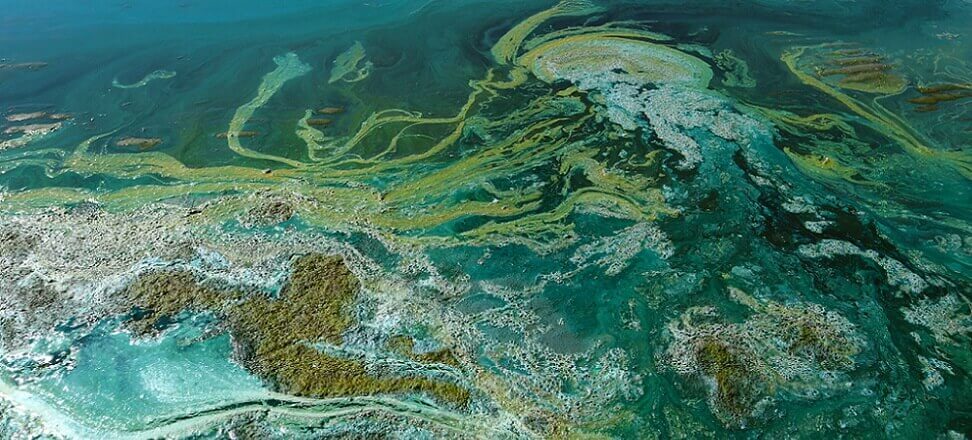The phenomenon of “blooming” waters, although present on Earth for a long time, is only now becoming more widely recognized and its negative consequences socially understood.
A bloom is a visible change in the color of water caused by excessive growth of cyanobacteria or algae. The color changes are clearly visible not only from the shore of the tank, but – in the case of heavy blooms – also from space.
Blooms – types and locations
Blooms can be caused by both micro- and macroalgae. If it was caused by cyanobacteria, the water has a distinct greenish-gray color giving the impression of poured green-blue oil paint. Depending on the species of cyanobacteria and the stage of the bloom, we may also see a distinct bluish, yellowish or reddish-brown coloration of the water. In the case of a bloom caused by eukaryotic microalgae, such as diatoms, the water turns brown, furrows turn brownish-red, euglenins turn red, goldworms turn brownish, haptophytes turn golden. The blooms formed by macroalgae are visible as large, distinct clusters of biomass on the water surface.
Blooms can appear in all types of water: rivers, lakes, ponds, seas, oceans and on all continents. The exception is Antarctica, but it cannot be ruled out that the phenomenon will also appear there in the future. They are observed practically at any time of the year, although summer is the period when they appear most intensively.
The effect of a bloom is not only a change in the color of the water, but often an unpleasant odor and the presence on the surface of drosses formed from the accumulation of overdeveloped cyanobacterial or algal biomass.
Water blooms caused by cyanobacteria
Many of the microorganisms that form blooms produce a variety of chemical compounds, including toxins, which, when excreted into the water, can cause numerous negative phenomena. This was particularly evident during last year’s bloom on the Oder River caused by haptophyte algae – Prymnesium parvum . However, by far more often we are dealing with blooms formed by cyanobacteria (cyanobacteria), whose name comes from the bluish (bluish) coloration caused by the presence of blue and red pigments (phycocyanin and phycoerythrin).
Cyanobacteria are photosynthesizing bacteria for which sunlight is a source of energy when convertingCO2 into biomass. Fossil evidence indicates that they occurred in large numbers on Earth more than 2.5 billion years ago, but may have appeared as much as 3.5 billion years ago. It is now accepted that they are the organisms that first produced oxygen and thus triggered one of the most important events on Earth, the emergence of oxygen conditions. In addition, they play a key role in global primary production and nitrogen fixation.
Although cyanobacteria have been present on Earth for a long time, many studies indicate that eutrophication, risingCO2 levels and global warming are responsible for the more numerous presence, intensity and duration of cyanobacterial blooms, especially in northern parts of the globe. This trend is dangerous, as cyanobacterial blooms cause a decline in biodiversity, can have detrimental effects on trophic networks, and pose a danger in the use of waters, such as for drinking, recreation or farming (fish farming, shellfish farming).
Cyanobacteria’s favorite weather, at which we can expect water blooms, is sunshine and no wind. Cyanobacteria-formed blooms are more common during hot summers than when summers are cool and rainy.
The unique abilities of cyanobacteria
The massive growth of cyanobacteria is an indicator of the abundance of nutrients in the aquatic ecosystem, especially such macronutrients as phosphorus and nitrogen. However, it happens that the available supply of these compounds will be depleted by the strong growth of other algae. Cyanobacteria store excess phosphorus in their cells in the form of polyphosphate. With such a supply, they can carry out cell divisions even when the external pool of the element has been depleted.
To obtain nitrogen they are able to use different sources of nitrogen: nitrate, nitrite, ammonia or urea. However, a hallmark of some cyanobacterial species is the ability to fix atmospheric nitrogen (N2). This ability is possessed by species referred to as diazotrophic. The fixation of atmospheric nitrogen is energetically costly due to the need to break the triple bond linking N2 molecules, as well as for the cell to maintain the nitrogenase enzyme required to catalyze the reaction. However, energy investments in nitrogen fixation may be offset by the competitive advantage provided by environments with significant nitrogen deficiency.
Species that can’t assimilate atmospheric nitrogen can use the reserves that are released into the water from the dying cells of species that can do so. The ability to bind N2 thus causes cyanobacteria to increase the pool of nitrogen in the aquatic environment by introducing it into the environment, thus affecting the global geochemical cycle of this element.
These unique abilities mean that cyanobacteria not only thrive in environments that are unfavorable to other organisms, but can also reproduce there very effectively.
Cyanobacteria blooms a source of disease and poisoning
Cyanobacteria have the ability to produce many chemical compounds. Some of them are harmful to humans and animals and have been ranked among the most toxic naturally occurring substances. Their lethal doses are compared with fungal (amanitins, phalloidin) or plant (aconitins, strychnines) toxins. Cyanobacteria toxins are very stable and remain active even after boiling the water.
Among cyanobacterial toxins are:
- Microcystins and nodularins classified as hepatotoxins. They are endotoxins, meaning they remain in the cells of cyanobacteria until they are damaged or die. To enter the cell, they require membrane transport provided by liver cells, making them the most vulnerable to the negative effects of this type of toxin. They affect the kidneys, gastrointestinal tract, reduce DNA repair capacity, and have carcinogenic effects. Currently known are approx. 250 congeners (types) of microcystins. Microcystins and nodularins can be accumulated in animal tissues. Their presence has been found in aquatic invertebrates and vertebrates: zooplankton, bivalves, shrimp, fish.
- cylindrospermopsin, an extracellularly secreted toxin. It can affect the liver, kidneys and erythrocytes. Its presence has been found in clams, snails, crayfish, fish and plants.
- anatoxin-a, classified as a neurotoxin that damages the central and peripheral nervous systems. Once ingested, it is quickly and passively absorbed and distributed to various organs, including the brain. Its effects can cause muscle paralysis and lead to respiratory failure. It accumulates in the tissues of fish (e.g. tilapia, carp, trout).
- saxitoxin produced by cyanobacteria, but also by marine dinoflagellates. Saxitoxin causes blockade of the sodium channel in nerve cells and the calcium and potassium channels in heart muscle cells. Its effects lead to typical neurological symptoms, such as nervousness, seizures, ataxia, and muscle and respiratory paralysis. Accumulation has been found in paddlefish(Daphnia), crabs, octopus, fish and mammals such as whales.
- anatoxin-a(s), which inhibits acetylcholinesterase at neuromuscular junctions, blocking the hydrolysis of the neurotransmitter. The result is an accumulation of acetylcholine. It leads to nerve hyperexcitability, resulting in muscle weakness, respiratory distress (shortness of breath) and convulsions that precede death, which occurs as a result of respiratory arrest in mammals.
- Dermatotoxins secreted by marine cyanobacterial species. They cause allergic reactions after direct skin contact.
- BMAA – is considered to be one of the causes of neurodegradative disease (parkinsonism) and Alzheimer’s disease. It accumulates in shellfish and fish.
- Cyanobacterial lipopolysaccharides (LPS), which are part of the outer membrane of most gram-negative prokaryotes, including intestinal bacteria and cyanobacteria. They can cause skin irritation, fever and nausea.
People who have had direct contact with water with the bloom may complain of skin allergies (rashes), eye irritation, as well as vomiting, diarrhea, fever, muscle and joint pain. There is evidence that toxic cyanobacterial blooms can cause disease and even death in dogs, horses, cattle, birds and fish. So if a water bloom occurs, avoid contact with the water and protect children and pets. Dog owners should not allow their dogs to play, swim or drink water from a reservoir where blooms are visible.
Cyanobacteria cells and their toxins are also present in aerosols floating near the shores of water bodies. If we inhale them, we may have respiratory problems. Fortunately, they pass quickly if you move away from the shore.
Not every bloom is a toxic bloom. But even the non-toxic ones are a dangerous phenomenon because they cause disruption to the ecosystem. The accumulation of organic matter due to the compaction of dying cyanobacterial cells, worsens the living conditions of other aquatic organisms. As a result of organic matter decomposition processes in the bottom layers of reservoirs, oxygen is depleted and oxygen deficits are created. Such conditions can cause massive die-offs of fish or aquatic invertebrates. Under anaerobic conditions, there is a release of ammonium ions, phosphate ions or hydrogen sulfide from the bottom sediments into the overlying water. Thus, the water body is enriched with nutrients internally.

Non-sinic blooms
Other, equally dangerous blooms are caused by species of eukaryotic algae, such as furuncles and haptophytes. The blooms formed by furrows are mostly formed in the oceans. The potent toxins they emit can cause damage and threaten the health and lives of humans and animals.
Haptophytes are also eukaryotic algae that inhabit brackish waters. We saw the negative effects of a water bloom formed in the Oder River by Prymnesium parvum, which belongs to haptophytes, last year, when thousands of tons of fish, mussels and other gill-breathing animals died.
“Golden alga” the cause of many problems around the world
Prymnesium parvum was first discovered in the brackish water of Bembridge Pond (Isle of Wight, England) and described by Carter in 1937. To date, its presence has been found on islands in the Atlantic Ocean, in the Baltic Sea, in the Black Sea, as well as in the Balkans, the United Kingdom, Ireland, Denmark, Finland, Spain, the Netherlands, Germany, Norway, Poland, Portugal, Romania, Russia, Sweden, Ukraine, the United States, Brazil, Israel, China, Australia and New Zealand, and in northern Africa (Morocco).
The cells of Prymnesium parvum have two chloroplasts of brown-gold color, which they owe to the presence of the dye fucoxanthin. For this reason, during the period of their mass development, the water turns golden in color, and the species is called “golden algae” literally translated as “golden alga (algae)”. This species is included in the euryhaline and eurythermal group, which means that it tolerates a wide range of salinity (1 to over 35 psu) and temperatures in the range of 2 – 32°C. It is a cosmopolitan species, found on all continents except Antarctica. It is most often associated with saline (estuarine) or brackish, marine waters, but is also present in inland waters, often those polluted (highly saline) and with high electrolytic conductivity.
P. parvum is a myxotrophic species, meaning that it has the ability to photosynthesize (autotrophy), but can also feed on dissolved organic matter, bacteria or protists (heterotrophy). Prymnesium has the ability to kill and eat species that compete with it or even are predators. Prymnesium myxotrophy increases as the availability of inorganic compounds decreases. Most blooms are formed by this species in nutrient-rich waters. Observations indicate that at a pH of 7 or lower, toxicity of the species does not occur. The factors that cause Prymnesium blooms most often are high temperature, increased salinity, changes in hydrology and increased nutrient concentrations. It is also understood that these may include changes in water hardness, the presence of herbicides and an increase in pH.
Prymnesium parvum produces a number of compounds, among which prymnesin, a potent fish gill (ichthyotoxin), is particularly well known. The effect of toxicity can be enhanced by a number of environmental factors. Some substances that have toxic effects on fish are sensitive to light, and their effects can be inhibited at pH 7 or lower.
Prymnesium parvum blooms cause the death of gill-breathing organisms: fish, mollusks, tadpoles. A common mode of action of Prymnesium is to destroy the selective permeability of cell membranes and disrupt ion regulation in the gills. Toxin-infected fish have characteristically bloody gills, which can produce a very thick layer of mucus. Then they swim slower and slower, lie down near the bottom, congregate near the shore, at fresh water springs or jump ashore.
Blooms – economic impact
Toxic blooms significantly affect the quality of life of people professionally involved in commercial fishing, restaurant owners, food stores, tourism and recreation. Millions of dollars a year are spent to make people aware of the impact of algal blooms on their health, as well as the damage to commercial fishing, recreation and tourism they cause, and how much environmental monitoring and management of blooms costs. Few people are aware of the hidden costs, such as supporting aquaculture, food processing, medical care for undiagnosed diseases, declining fish and seafood consumption, and losses in tourism. Here are some examples:
- In South Africa, the massive die-off and decay of the cyanobacterial bloom caused the rapid emergence of anaerobic conditions, and this in turn triggered a mass exodus of lobsters, which, despite the military’s involvement in their rescue, were harvested and eaten by the local population.
- A blue-green algae bloom covering 2,400 square kilometers of China’s Taihu Lake has left 2 million people without drinking water for a week.
- A blue-green algae bloom on Lake Erie covered 5,000 square kilometers of its surface and resulted in a 48-hour water ban for 400,000 residents of Toledo, Ohio, USA.
- It was estimated that the cost of medical care for stomach ailments caused by cyanobacterial toxins was: for light cases – $86, for medium cases – $1,1015, and for severe cases – $12,605; the cost of medical care for respiratory ailments was estimated: for light cases – $86, for medium cases – $1,235, and for severe cases – $14,600.
Short-term blooms in naturally eutrophic waters are a natural phenomenon. However, these are lasting longer and occurring more frequently and are the result of global change and increasing anthropopression. If we want to have clean rivers and lakes, we need to start taking care of them and stop treating them like a garbage dump into which everything can be thrown (dumped).

 Polski
Polski






